Project Profiles in New Brunswick
Learn more about some of the projects in New Brunswick by selecting a community name:
- Allardville
- Atholville
- Bath
- Bathurst
- Bay of Fundy
- Belledune
- Bouctouche
- Dieppe
- Drummond
- Fredericton-Perth-Andover
- Grand Falls
- Grand Manan
- Grande-Anse
- Hartland
- Harvey
- Johnson's Mills
- McAdam
- Miramichi
- Moncton
- Gas Tax Fund Project in Nigadoo
- Port Elgin
- Richibucto
- Sackville
- Saint John
- White Brook
- Zealand
Federal Gas Tax Fund supports sustainable wastewater management

Project location: Allardville
Recent wastewater management system upgrades in Allardville will help safeguard local groundwater resources, while lowering home maintenance costs for residents.
The municipality expanded the community's central sewage treatment system. Underground collection pipes were extended by nearly 1,800 metres, creating new connections to 53 residences and allowing their individual septic systems to be retired. A wetland lagoon was also expanded to accommodate increasing volumes of wastewater.
The work increased the community's wastewater treatment capacity and helped protect the groundwater supply. In the long run, the project eliminated the private septic system maintenance costs for the owners of the newly serviced homes.
By dedicating a portion of their federal Gas Tax Fund allocation to proactive wastewater management improvements, Allardville has strengthened the foundation for their community's long-term health and prosperity.
Federal Gas Tax Fund helps community modernize its water and wastewater infrastructure

Project location: Atholville
The Village of Atholville is a small community of about 1,200 located on the south shore of the Restigouche River next to Campbellton. It sits at the entrance to Sugarloaf Provincial Park and is home to a pulp mill that is the largest single employer in the region.
As with many older communities, some of Atholville's underground waste and wastewater systems had become dated and unreliable. To address this issue, the town created a multi-year modernization program to update its underground infrastructure.
With help from the federal Gas Tax Fund, one of the projects in this program is now complete. Four hundred and fifty metres of sewer, water and storm-water mains were replaced under Ferguson Street. During the repaving, new gutters and curbs were also added.
This project will help provide residents with better water quality and wastewater management services for years to come, as well as improve curb appeal for local businesses.
Small upgrades, big difference
Protecting public health and the environment

Project location: Bath
Sometimes small upgrades make the biggest difference.
Power interruptions didn't happen often in Bath but when they did, the village's water supply could be in jeopardy.
With the help of $20,000 from the Communities Component of the federal Building Canada Fund, officials in Bath purchased an automatic starter for the generator at the main well house, generators for two booster stations and a new automated chlorination system to meter and chlorinate water more accurately.
This infrastructure ensures a continuous supply of power to pump water and maintain the pressure in the lines, even during power failures. They also ensure consistent water quality, which will prevent boil-water orders, and more efficiently run water treatment operations.
According to Mayor Troy Stone, these three small upgrades advance "the safety and security of the village's water supply…to the highest level possible."
Bath can now move forward to attract new residents and businesses with assurances about the safety of a critical community component – safe, reliable drinking water.
Federal contribution: $20,000
Reduced risk of sewage system failures in Bathurst

Project location: Bathurst
The City of Bathurst was one of the New World's first permanent settlements and is situated on the shores of Chaleur Bay overlooking the Atlantic Ocean. The City's economy was initially rooted in forestry, then mining. Now, it is a more economically diversified and family-oriented city that attracts a highly skilled workforce.
There were growing concerns that two sewage lift stations built in the early 1970s were at risk of failure. Located in residential areas of the city, a functional failure could back sewage into houses or waterways. Maintenance was also a challenge because of outdated pump controls.
Supported by a federal contribution from the Communities Component of the Building Canada Fund, Bathurst has installed new equipment at the lift stations on both Bridge Street and Vallée Lourdes Drive. All controls have also been improved and are now easy to access.
Federal contribution: $423,358
Another leg of the Fundy Trail now complete

Project location: Bay of Fundy
The Fundy Trail is a multi-use coastal route that has opened up previously unreachable areas of the Bay of Fundy for exploration and sightseeing. Winding along the province's southern coast, it includes a pedestrian/bike trail, footpaths to beaches and river estuaries, as well as an interpretive centre that brings the rich history of the area to life.
One of the easiest ways to see one of world's most stunning coastlines is from the comfort of your vehicle. The paved, low-speed auto parkway that forms part of the trail is dotted with scenic lookouts and is easily accessible from the Trans-Canada Highway.
Thanks to the Government of Canada's Provincial-Territorial Base Fund the province has completed 11 more kilometres of the parkway. The federal funds also supported the design and construction of critical parkway elements from the intersection of Old Salmon Road and Route 114 near the entrance to Fundy National Park toward Seely Beach and Tufts Point.
Tourists and locals alike now have better access to one of the last coastal wilderness areas between Florida and Labrador, not to mention world-renowned opportunities for viewing marine life.
Federal contribution: New Brunswick is receiving $175 million through the Provincial/Territorial Base Fund for initiatives across the province.
Expanding potential for economic growth in New Brunswick
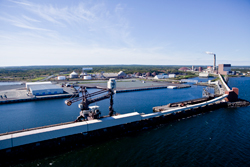
Project location: Belledune
The Port of Belledune is a major deep water port located on a protected bay that feeds into the southern Gulf of the St. Lawrence. It offers year-round handling capacity for ships moving cargo between points in Europe and North America and provides intermodal connections to trans-continental rail and road systems to key markets in Canada and the northeastern United States.
In 2008, a structural assessment found that one of the Port's three terminals needed refurbishing. With financial support from the federal Infrastructure Stimulus Fund, the Belledune Port Authority completed the required upgrades, built a new 18-hectare storage area for larger vessels and added a roll-on-roll-off barge terminal on the wharf for wheeled cargo.
This work has made it possible for the Port to expand its operations and offer more competitive services. Beyond boosting business for the Port, the improvements are bringing spin-off economic benefits to the entire region. In speaking about the project, Rayburn Doucett, President and Chief Executive Officer of the Port of Belledune, called it "the beginning of the transformation of northern New Brunswick's economy."
Federal contribution: $26,400,000
New Civic Centre with economic benefits
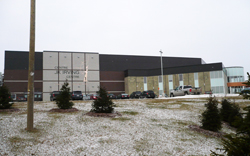
Project location: Bouctouche
Thanks to an investment from the federal Infrastructure Stimulus Fund and funding from the municipal and provincial governments, the town of Bouctouche, located 40 kilometres northeast of Moncton on the Northumberland Strait, has a new municipal building.
The facility houses the town hall and municipal offices along with community meeting rooms, an indoor jogging track and a regulation-size hockey rink with seating for 1,000 people. The centre replaces a number of outdated buildings that were getting expensive to maintain and no longer met community needs.
The town expects significant long-term cost benefits through shared building administration and management fees as well as reduced operating costs. Bouctouche Mayor, Aldéo Saulnier, described the new facility as a "tremendous addition to the town of Bouctouche and the entire region,"
also pointing out the significant economic boost the project gave the community during the economic downturn.
Federal contribution: $5,000,000
Improved mobility for a growing city

Project location: Dieppe
Located along the Petitcodiac River, the City of Dieppe is just east of Moncton. Its population has more than quadrupled in less than 30 years, making it one of the fastest growing municipalities in the Maritimes and the fifth fastest growing in Canada.
Bustling with commercial activity, Dieppe's roads handle significant traffic. Paul Street is one of the City's busiest streets with up to 30,000 vehicles travelling the route daily. To keep people and goods moving efficiently, the City initiated a major road rehabilitation project in 2010.
Thanks to financial support from the federal government's Gas Tax Fund, work to widen the street to six lanes between Route 15 and Sunset Street and add dedicated turning lanes is now complete. The City replaced the underlying water main at the same time to save on future repair or replacement costs and reduce the potential for future traffic disruptions.
Now lined with trees and flowers, Paul Street incorporates a new sidewalk on one side and a new multi-use pathway on the other side to help encourage more active forms of transportation.
Rehabilitating this road has greatly improved traffic circulation, which will help reduce greenhouse gas emissions. The project has also provided more options for commuters who would rather leave their cars at home.
Restoring a well-used agricultural route

Project location: Drummond
Home to the Potato World Museum, Drummond is an agricultural community focused on potato production for inter-provincial and international markets.
Once harvested, potatoes are shipped to processing plants in transport trucks along Route 108, which runs through the centre of the province from east to west. This busy collector highway provides easy access to Routes 105, 130 and the Trans-Canada Highway.
Over time, weather and traffic volumes had caused some dangerous pavement deterioration to sections of Route 108 between the Town of Drummond and Davis Mill Road. Potholes and rutting were compromising driver safety and the road no longer met Transportation Association of Canada guidelines.
Thanks to support from the federal government's Infrastructure Stimulus Fund, these sections have now been repaved.
As the primary route through Drummond, keeping Route 108 in top shape is important for local agricultural producers. It also helps smooth the way for tourists interested in discovering the impact of the humble potato on the survival of New Brunswick's early settlers, and on the province's economy today.
Federal contribution: $1,500,000
Highway construction and rehabilitation of Routes 101, 102, and 109

Project location: Fredericton and Perth-Andover
With funding from the Infrastructure Stimulus Fund, these highway projects, which have a total cost of $4.2 million, will assist in extending the life of the highways while improving road safety. The federal government contributed over $2.1 million towards the projects which improved the highways for the benefit and safety of New Brunswick's drivers.
Federal contribution: $2,100,000
Road improvements in Fredericton

Project location: Fredericton
An investment through the Infrastructure Stimulus Fund of Canada's Economic Action Plan is improving roads in Fredericton.
Construction and rehabilitation along 9.5 kilometres of the City's Route 101, from New Maryland village and O'Leary Road means a smooth and safer ride for drivers.
Work began and was completed in July 2009. It involved replacing two cross-roadway culverts, cold milling the roadway surface and a fresh layer of asphalt.
This project also involves the improvement of 2.4 kilometres of Route 102. This multi-lane roadway in Fredericton and provides a vital connection between downtown and northern parts of the City. Work includes cold milling the main lanes and on- and off-ramps, followed by a new layer of asphalt.
"This project was a success because it improved the roads for the benefit and safety of the drivers,"
says Kevin McKnight, Resident Engineer, Department of Transportation.
Federal contribution: $1,350,000
State-of-the-art Fredericton Convention Centre complete

Project location: Fredericton
In January 2011, Fredericton became the proud owner of Atlantic Canada's newest, state-of-the-art meeting and convention centre.
Built to meet Silver LEED certification requirements, the 20,116-square-metre facility houses a theatre for up to 1,500 people for concerts and other major events. It also features a ballroom, business centre, commercial kitchen, and teleconferencing and multi-media facilities equipped with cutting edge technology.
The new centre will draw more national and international conferences to the city as well as more tourism to the region. It will also support functions held by the many knowledge-based industries, and research and development organizations that make the provincial capital their home.
New Brunswick identified the project as a priority in their 2008-2009 Annual Capital Plan for funding through the Government of Canada's Provincial-Territorial Base Fund. The total cost of the construction was approximately $27.9 million. The City of Fredericton and Province of New Brunswick also provided a portion of the funding.
"The Fredericton Convention Centre is part of a transformative project for the east end of our downtown,"
commented Mayor Brad Woodside. "Not only will it result in new tourism and event business, but it is sure to serve as a catalyst for additional development."
Federal contribution: New Brunswick is receiving $175 million through the Provincial-Territorial Base Fund for initiatives across the Province.
Federal Gas Tax Fund contributes to a "greener" Fredericton

Project location: Fredericton
Multi-use trails are contributing to a greener and more active Fredericton thanks to financial support from the federal Gas Tax Fund.
The City has been investing Gas Tax funding into transforming abandoned rail lines into scenic trails since 2008. To date, this has resulted in 14.8 kilometres of trail for people to enjoy.
The 3.5-metre pathways provide connections between neighborhoods and to the downtown core by linking up with existing sidewalks and trails. They help encourage residents to get outdoors and take their feet or bikes to work instead of their cars. They also expand outdoor recreational opportunities for runners, rollerbladers and cross-country skiers. The trails are wheelchair and stroller accessible, meaning everyone gets to enjoy more fresh-air experiences in this provincial capital.
Expanding active transportation options is helping Fredericton reach its goal of reducing greenhouse gas emissions. A trail system can reduce short-distance motor vehicle trips, which are considered to generate the most pollution per kilometre and to be the least fuel-efficient.
Trail development has also been linked to stimulating the local economy. According to the New Brunswick Trails Council, trails in the province employ approximately 1,500 people for an average of six months a year. At the same time, multi-use pathways help attract tourists, residents, and businesses to a city.
With help from the federal Gas Tax Fund, the City of Fredericton is using this predictable, long-term federal funding program to build a greener city for all to enjoy.
Safer driving in Grand Falls
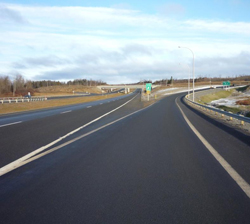
Project location: Grand Falls
Motorists in Grand Falls are more safely accessing Route 108 from the Trans-Canada Highway (Route 2) thanks to changes in the intersection configuration.
The previous intersection layout only permitted right turns at this busy intersection. Those drivers wanting to make a left turn onto Route 108 could not. Some attempted it, often with serious consequences. There were many accidents.
With assistance from the federal Infrastructure Stimulus Fund, the right-turn ramp was reconfigured to improve traffic flow and a new left-turn lane was added to increase driver safety.
With these improvements, people and goods passing through Grand Falls can now reach their destinations more safely and efficiently.
Federal contribution: $1,500,000
Ensuring reliable water services
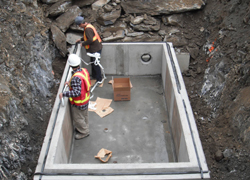
Project location: Grand Falls
During the last few years, the Town of Grand Falls made important investments to improve its water systems. These infrastructure projects not only improved water quality and reliability for existing residents, but also extended water services to areas slated for future development.
Grand Falls used a portion of its federal Gas Tax Fund allocation to complete the looping of two sections of existing water mains between Beaulieu Street in St. George and the CN road in the industrial park. This is an area of town where many businesses and residences were previously served by only one water main. If there was a shut down or line failure, the entire area was at risk of being without water until repairs could be completed.
A portion of the looping was completed by drilling under the river — a major undertaking. The project also included the installation of new fire hydrants, valves, pressure reducing valves and junctions.
By connecting the water mains, this project improved the water supply and fire-suppression reliability. With this work now complete, Grand Falls is hoping to attract new businesses to the region and expand the industrial park.
Green heating for community multi-plex

Project location: Grand Manan
The Village of Grand Manan is located on a small island in the Bay of Fundy that is only accessible by ferry and plane. Given its remote location, having as many services as possible directly available on the island is important to the community's 2,500 residents. Equally important is making sure any new development doesn't interfere with the island's beautiful natural environment.
With these goals in mind, the Village used financial support from the federal Gas Tax Fund to build a new multipurpose complex. The fund provides communities with stable funding to support environmentally friendly projects. This project also benefited from an additional federal investment through the Municipal Rural Infrastructure Fund.
The complex incorporated a number of energy-saving devices, such as geothermal heating, which extracts the natural heat available in the ground water to moderate the building's internal temperatures. The system helps reduce greenhouse gas emissions and energy consumption.
"Financial support through the federal Gas Tax Fund has helped provide our community with a first-class multipurpose complex,"
said Rob MacPherson, Grand Manan Chief Administrative Officer. "The environmentally sustainable geothermal system has allowed for energy-efficient and cost-effective heating of the building."
The complex is now accommodating a wide range of community activities, from sporting events to gatherings of the local Boys and Girls Club.
Federal contribution: $1,134,086 from the Municipal Rural Infrastructure Fund + Gas Tax funding.
Enhancing tourism through better highways

Project location: Grande-Anse
With $454,500 from the federal Infrastructure Stimulus Fund paved Route 11 through Grande-Anse to support local business and tourism opportunities.
The Village of Grande-Anse serves as a gateway to the Acadian Peninsula. To improve highway safety and enhance visitors' impressions of the region, rehabilitation of Route 11 through the village became a priority project.
The highway connects with Moncton in one direction and meanders along the coast, offering spectacular views of Chaleur Bay, before arriving in Campbellton and linking with the Quebec highway system in the other direction. As such, tourism traffic can be heavy along Route 11 and encouraging visitors to stay awhile in towns served by the highway is important to the economic stability of the area.
Federal contribution: $454,500
Busy bridge gets much-needed upgrades

Project location: Hartland
Hartland is situated on the picturesque Saint John River in the agricultural heartland of Carleton County.
An important bridge in the area, the Hugh John Flemming Bridge, spans the river on collector highway Route 130. It is a vital transportation link for Carleton County residents and commercial traffic. It also forms part of the River alley Scenic Drive, referred to as "400 miles of inspiration" on the Travel New Brunswick web site, which attracts numerous tourists to the area each year.
To help bring this 50-year-old bridge up to current safety standards, five of the bridge's approach spans have now been rehabilitated thanks to a contribution from the federal Infrastructure Stimulus Fund. The associated barrier walls were also replaced.
The completion of this first phase has made great strides in realizing a longer-term plan to completely rehabilitate this important transportation link. Already, this work is improving driver safety, strengthening the province's transportation network and reducing maintenance costs.
Federal contribution: $591,000
Brownfield remediation

Project location: Harvey
With $59,989 from the Communities Component of the federal Building Canada Fund, the small village of Harvey, about 35 kilometres southwest of Fredericton, has turned a derelict eyesore in the centre of town into a space that can be used for the community.
An abandoned wood mill had become a hazard. Rotting piles of cedar leaned in all directions and posed a constant fire hazard. There was also a risk of the abandoned mill operations contaminating the village's water supply.
In January 2010, crews began clearing away the rotting wood and debris, providing much-needed jobs during the colder months. Former Mayor Winston Gamblin acknowledged the importance of winter-time employment to his community and spoke of the benefits of having space in the centre of the village become available for redevelopment.
Now that the site remediation is complete, the land has become a good candidate for a community-service facility. Ideas include a seniors' residence, recreational structure or social housing.
Federal contribution: $59,989
Eco-sensitive road relocation

Project location: Johnson's Mills
The force of tidal wave action poses serious maintenance challenges for crews trying to maintain coastal roads.
Along Shepody Bay, the innermost arm of the Bay of Fundy, Route 935 required repeated stabilization to make it safe for area residents and visitors. This area is home to Canada's first Western Hemispheric Shorebird Reserve at Johnson's Mills, where nutrient-rich mudflats and roosting beaches attract millions of migrating shorebirds every summer. The birds, in turn, attract bird watchers and other tourists from all over the world. Route 935 takes these visitors to the mudflats.
Over time, rerouting part of Route 935 away from the eroding bank of Shepody Bay became the most practical solution. With an investment of $1 million from the federal Infrastructure Stimulus Fund, the Department of Transportation of New Brunswick was able to undertake the eco-sensitive task of relocating 2.3 kilometres of Route 935 further inland.
The relocation of the road helps take traffic out of the buffer zone that is crucial to the ecological integrity of Shepody Bay. It also eliminates the repeated stabilization efforts and provides anyone using the road with safe access to the Shorebird Reserve.
Federal contribution: $1,000,000
More competitive shipping

Project location: McAdam
The New Brunswick Southern Railway (NBSR) operates 364 kilometres of track between Saint John and the Maine border and from McAdam to St. Stephen. It offers direct access to the Port of Saint John and connections to other railroads operating in the Maritimes. It also operates several truck-rail reload operations that include logging, chemicals and dry-bulk transfers.
Now, thanks to $9 million from the federal Infrastructure Stimulus Fund, matched by the province and doubled by the company, theas NBSR has taken steps to stay competitive.
Work crews replaced, upgraded and fortified ties, steel rails, rail beds and bridges, and renovated the terminals in Saint John and McAdam.
The upgrades allow NBSR to carry heavier loads along its lines, something that had hindered its past competitiveness. This also means rail cars can be interchanged with other railroads for even greater efficiency.
The improvements are providing better connections to the region's transportation corridors and better market access for rural shippers. In reducing the use of truck transportation, the regional road infrastructure will also benefit, as will the environment from reduced greenhouse gas emissions.
The railway upgrades are also benefiting NBSR users. The Ganong chocolates plant in St. Stephen, for example, relies on the bulk shipment of sweeteners by rail.
Federal contribution: $9,000,000
Quick start to important clean water project
Project location: Miramichi
Miramichi is situated at the mouth of the Miramichi River and is the largest city in northern New Brunswick. It has a proud Acadian heritage and an even more promising future with a growing number of business, tourism and recreation opportunities cropping up in the area.
To help support this growth, the City applied for assistance from the Communities Component of the Building Canada Fund to tackle sewer system issues that had become an ongoing concern.
Dating back to 1955, the aging system frequently overflowed, and put undue pressure on its undersized main. This caused many breaks requiring costly repairs and compromised the City's water quality.
This project was able to get off the ground quickly thanks, in part, to the accelerated federal environmental assessment process established in 2009. Work to renew existing infrastructure can now move forward faster because of the streamlined process.
Prompt replacement of the water, sanitary and storm sewer infrastructure on Newcastle Boulevard, one of the City's main arteries, will significantly reduce operation, maintenance and property damage costs. It will also help ensure residents always have high-quality drinking water.
Federal contribution: $1,333,333
Safe drinking water and sewer drainage for Miramichi residents
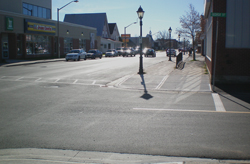
Project location: Miramichi
Miramichi is the fourth largest city in the province and its officials work hard to keep the city amenities in top shape.
With old sewer and water pipes positioned side by side, there was a risk that drinking water would become contaminated if a sewer pipe burst. To reduce this risk, officials knew they had to replace 100-year-old water distribution lines, defective sanitary sewer pipes and a section of storm sewer along Pleasant Street between Jane Street and Newcastle Boulevard.
Thanks in part to a federal government financial contribution through the Communities Component of the Building Canada Fund and the expedited environmental assessment provisions included in the Economic Action Plan, the work was able to proceed.
To further reduce the risk of water contamination and incidence of untreated water flowing onto city streets, the City installed a water-tight piping system that provides back flow detection and water meters equipped with remote read technology.
Now complete, the drinking water, storm water and waste water will all flow well for years to come. At the same time, the municipality is enjoying lower maintenance costs.
Federal contribution: $492,739
New interchange helping local business grow

Project location: Moncton
The Scoudouc Industrial Park in the Shediac-Moncton region is an important contributor to the economic development of the entire Greater Moncton region. Access to this commercial activity centre has greatly improved thanks to a contribution from the federal Infrastructure Stimulus Fund.
With construction complete on a new diamond interchange and connector road, commercial truck traffic now has a direct route into the park off busy Route 15. Before these road modifications, traffic around the industrial park was chronically congested. This caused costly delays for commercial vehicles and compromised the safety of other drivers.
With truck traffic now diverted, road safety has increased and travel times decreased.
Federal contribution: $3,136,500
Efficient planning leads to better traffic flow
Project location: Nigadoo
The francophone village of Nigadoo is located in northern New Brunswick near the Nigadoo River. Due to years of wear and tear, many of the village's roads were in bad shape and required resurfacing.
Thanks to financial support from the federal Gas Tax Fund, Nigadoo motorists are enjoying better conditions on several local roads. Previously, Rue de la Source, rue des Cèdres and rue du Parc had been chipsealed, a pavement surface treatment that is less costly than asphalt, but also less durable in the long run. Now, the roads have been repaired and newly surfaced with asphalt.
The more sustainable road has improved driving conditions and will help reduce maintenance costs for both the village and motorists.
Helping small communities upgrade facilities

Project location: Port Elgin
Small communities struggle to maintain and enhance municipal infrastructure. In Port Elgin, a small village near the Nova Scotia border, a 30-year-old, underground unit for treating wastewater had become expensive to maintain and was out of date technologically.
That changed thanks to funding to upgrade wastewater treatment from the Communities Component of the Building Canada Fund.
Construction got underway on an above-ground unit that meets current standards and is much easier to maintain. Features include a dedicated flow meter, ultrasonic monitoring that allows operators to track unusual flow rates or identify major groundwater infiltrations, and software that the operator can use to monitor the system through the Internet.
The new technology enables Port Elgin to anticipate problems and respond quickly. This means long-term savings for the village.
Federal contribution: $127,907
Safe, reliable drinking water
Upgraded water distribution

Project location: Richibucto
Construction is now complete on an upgrade to the water distribution system in the francophone town of Richibucto.
Richibucto's proximity to Northumberland Strait affected the town's water supply. The salt water that infiltrated existing wells could result in the creation of dangerous levels of trihalomethane (THM) in the municipal water system.
With the risk posed by THM, Richibucto used a contribution from the Communities Component of the Building Canada Fund to develop and deliver a new source of potable water to the community. Workers built a pump house and water main to link the new well to the town's existing treatment plant. Funds were also used to renew the water main along Acadie Street, a major thoroughfare in the town.
The water supply in Richibucto is now safe and reliable with THM levels below the limits identified by Health Canada.
Federal contribution: $315,974
Peace of mind

Project location: Sackville
A large fire in 2006 near a downtown intersection in Sackville almost destroyed the town of about 5,400 people. Located in southeastern New Brunswick, near the Nova Scotia border, Sackville's water supply could not keep up with demand, and crews ended up trucking water over five kilometres to keep the fire from spreading to nearby buildings.
Townsfolk had been talking about a new water tower for more than 30 years, because of limited flow and pressure problems with the existing system. But, like many small communities, money for infrastructure projects was hard to find. After the fire, a new water tower and supply system became a priority in Sackville.
Now, thanks to a contribution from the Communities Component of the federal Building Canada Fund, an elevated water tank is in place that provides extra storage, enhanced water quality and an equalized water distribution system.
The increased storage and system looping of the tower permits operators to flush the existing water distribution network properly. New monitoring equipment also allows chlorine levels to be easily checked and adjusted.
Mayor Patricia Estabrooks echoes the relief of many Sackville residents. For them, the new tower "eliminates serious concerns over water flow and availability in the event of another major fire."
Federal contribution: $1,215,121
Federal Gas Tax Fund supports eco-friendly municipal hub

Project location: Sackville
Sackville’s new Emergency Response Services and Town Hall facility brings the Town Hall, fire department and RCMP together under one roof for the first time.
The striking new building also earned a silver certification for Leadership in Energy Efficient Design. To achieve this level of green design, the Town used part of its federal Gas Tax Fund allocation to incorporate numerous energy-saving devices, including a ground source heat exchange system, occupancy sensors to control HVAC and lighting, heat recovery on all exhaust air units, LED exterior light fixtures, and in-floor heating distribution.
The project also received a Green Municipal Fund grant from the Federation of Canadian Municipalities, another testament to the project’s environmental stewardship.
The new facility takes the place of four outdated structures and is a shining example of what can be achieved in environmental and workplace efficiency. On top of saving energy, sharing space and services will significantly reduce ongoing operating and maintenance expenses for years to come.
Reduced operating costs
Enhanced recycling, more jobs

Project location: Saint John
A desire to facilitate the recycling process and reduce the volume of recyclable materials ending up in landfills prompted a $220,477 contribution from the Communities Component of the federal Building Canada Fund to improve material recovery in Saint John.
The Fundy Region Solid Waste Commission used the funds to build a sorting conveyor to simplify the separation of recyclables. New baling equipment also meant the sorted materials could be packaged on site for direct shipment to buyers.
With the new equipment, the Commission now manages recyclables more efficiently. This means reduced operating costs and the ability to react quickly to ever-changing markets for recyclables, further maximizing potential revenue streams. The Commission also has more flexibility to add materials to the recyclables collected in Saint John.
The new conveyor and baler meant one more full-time and 10 part-time positions at the sorting plant.
Increased public participation ensures fewer recyclables end up in landfills, which means less pressure on landfill sites and more efficient use of collection trucks. Both lead to a cleaner environment and reduced operating costs, something local residents are quickly embracing. Improved sales of recyclable materials also means the City of Saint John can take on additional environmental initiatives.
Federal contribution: $220,477
Out with the old, in with the new

Project location: Saint John
A key part of Saint John's water treatment system recently received a complete overhaul. The Pipeline Road West Water Transmission Main is one of six water projects funded through the Government of Canada's Infrastructure Stimulus Fund.
"This water transmission main project is an important part of a series of projects to improve the water quality in Saint John and deliver fully treated drinking water to the whole city,"
explains Dean Price from Municipal Operations and Engineering with Saint John's Public Works Department.
With some of the oldest operating watermains in the country, Saint John's water infrastructure was outdated and expensive to maintain. The quality of the drinking water had become a concern, and the City had been forced to add more chlorine to the system to safeguard against health issues. This was a costly measure that also left a 'bad taste' in consumers' mouths.
This project involved replacing a heavily corroded copper transmission main that was first installed in 1898. The new line will greatly improve water quality for Saint John residents at a much lower cost over the long term.
Federal contribution: $1,900,000
Investing in feeder highways
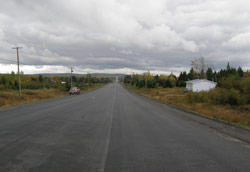
Project location: White Brook
Route 17 in northern New Brunswick connects parts of the Gaspé Peninsula and the Baie des Chaleurs area with the Trans-Canada Highway and a border crossing into the State of Maine. As such, it is a key transportation corridor supporting the national highway systems in both countries – and was in need of upgrades.
The Province applied for a $918,000 contribution from the federal Infrastructure Stimulus Fund, to be matched by provincial funding, to rebuild a stretch of Route 17 between White Brook and Kedgwick in the central part of northern New Brunswick.
Work included patching dangerous ruts and cracks, resurfacing the road with fresh asphalt and smoothing out the grade. Passing lanes were added, shoulders widened and upgraded guardrails installed.
With a stronger pavement structure and smoother surface, the danger of hydroplaning has been reduced and traffic flow should improve significantly. The upgrades also mean less long-term road maintenance, increased safety and reduced wear on vehicles.
Federal contribution: $918,000
Bridging a community divide

Project location: Zealand
Thanks to a contribution from the federal Infrastructure Stimulus Fund, the replacement of the historic Stone Ridge Bridge in Zealand is complete.
A victim of arson in October 2008, the last covered bridge in this small York County town has been sorely missed by residents. Not only had it connected two small communities on both sides of the Keswick River for nearly a century, its loss has been forcing people to drive nine kilometres out of their way to cross the river.
"I live in a small, rural community, where you could look across the river and see family and friends,"
remarked Wendy Brewer, resident of Upper Stone Ridge. "The [new] bridge represents the re-connection of two small communities, and all the family and friends who live on both sides of the river."
The new, pre-fabricated truss bridge will restore short travel times for drivers and help improve safety by reinstating a direct route for emergency vehicles to homes on both sides of the river.
Federal contribution: $180,000
- Date modified: